Roselle (Hibiscus sabdariffa) is a species of Hibiscus probably native to West Africa,used for the production of bast fibre and as an infusion, in which it may be known as carcade. It is an annual or perennial herb or woody-based subshrub, growing to 2–2.5 m (7–8 ft) tall. The leaves are deeply three- to five-lobed, 8–15 cm (3–6 in) long, arranged alternately on the stems.
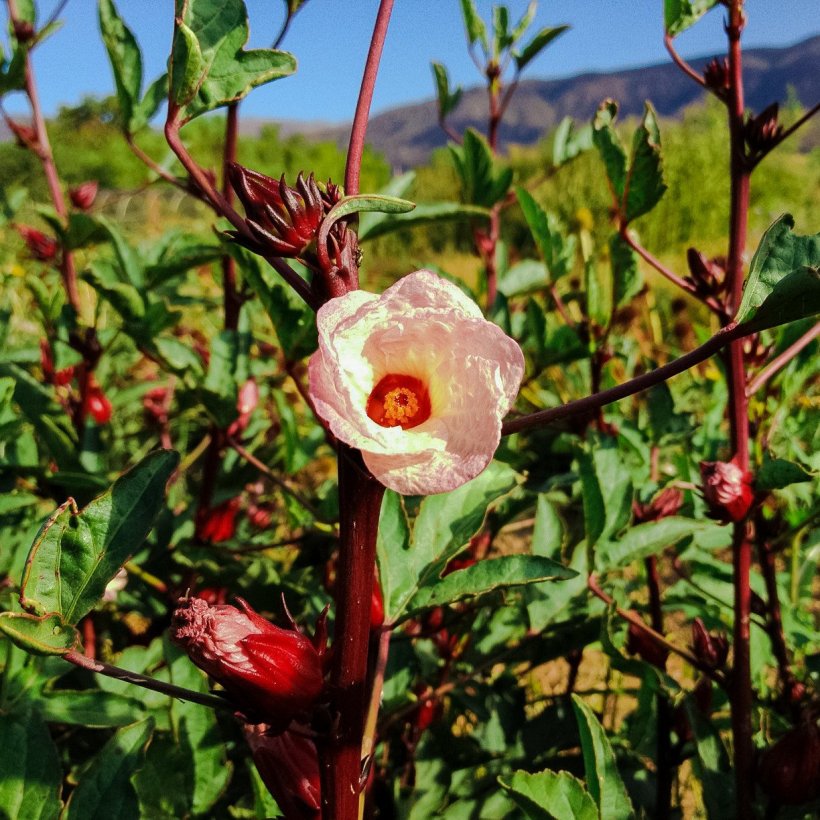
The flowers are 8–10 cm (3–4 in) in diameter, white to pale yellow with a dark red spot at the base of each petal, and have a stout fleshy calyx at the base, 1–2 cm (0.39–0.79 in) wide, enlarging to 3–3.5 cm (1.2–1.4 in), fleshy and bright red as the fruit matures. They take about six months to mature
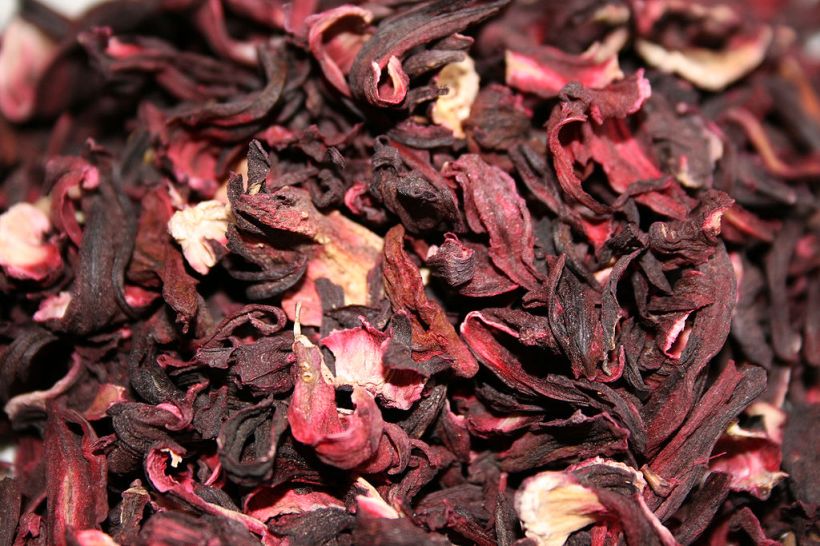
The roselle is known as the rosella or rosella fruit in Australia It is known as ‘Belchanda’ among Nepalese, Tengamora among Assamese, “Gal•da” among Garos, “Amile” among Chakmas.
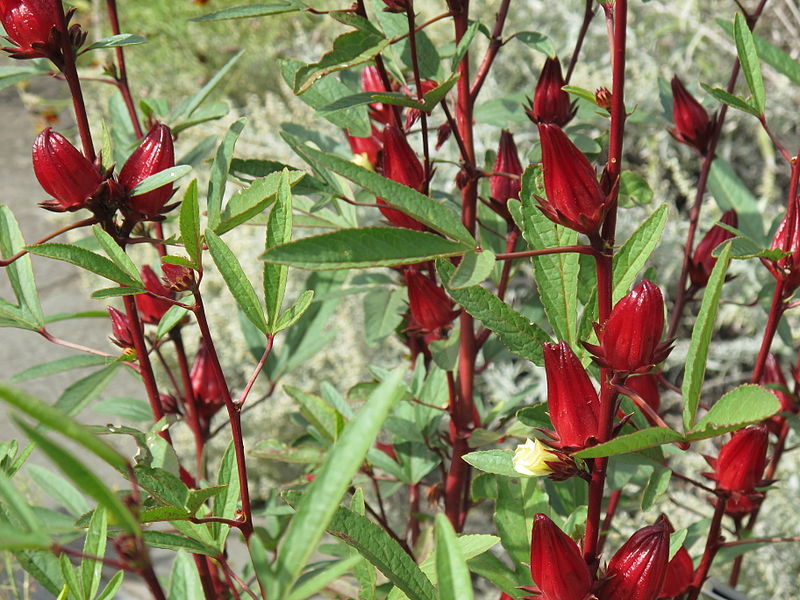
Uses
The plant is primarily cultivated for the production of bast fibre from the stem. The fibre may be used as a substitute for jute in making burlap. Hibiscus, specifically roselle, has been used in folk medicine as a diuretic and mild laxative.
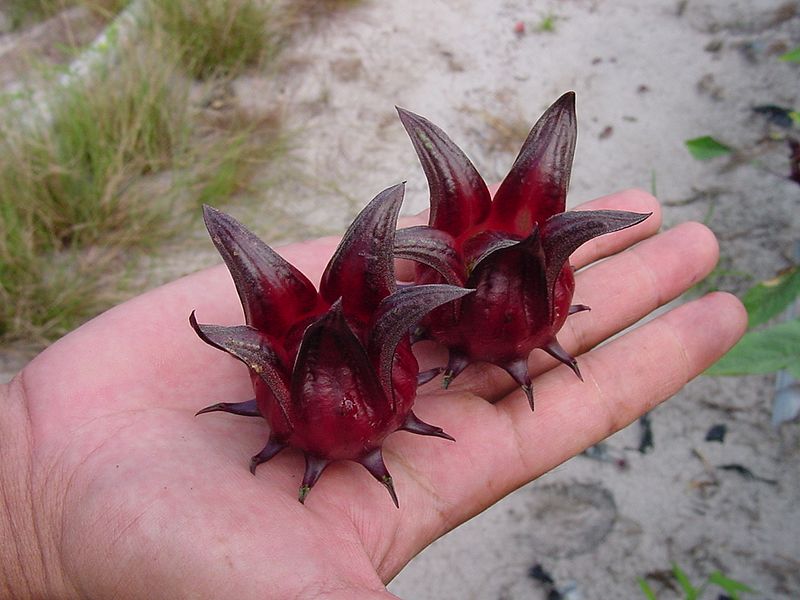
The red calyces of the plant are increasingly exported to the United States and Europe, particularly Germany, where they are used as food colourings. It can be found in markets (as flowers or syrup) in places, such as France, where there are Senegalese immigrant communities. The green leaves are used like a spicy version of spinach. They give flavour to the Senegalese fish and rice dish thieboudienne. Proper records are not kept, but the Senegalese government estimates national production and consumption at 700 t (770 short tons) per year. In Burma their green leaves are the main ingredient in chin baung kyaw curry.
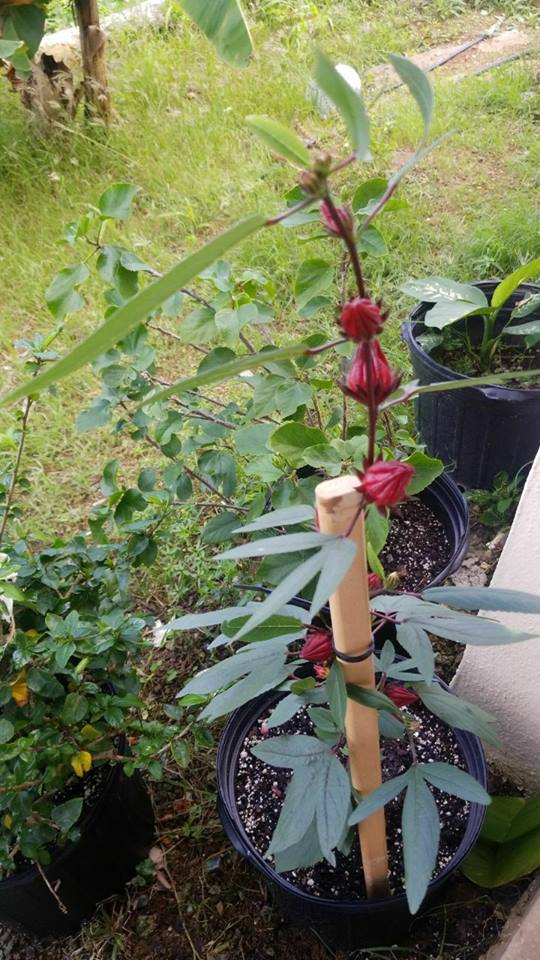
Brazilians attribute stomachic, emollient, and resolutive properties to the bitter roots.
Vegetable
In Maharashtra, roselle is called Ambadi. The Ambadi leaves are mixed with green chillies, salt, some garlic to prepare a chutney which is served with Jowar or bajra made bhakri. This is eaten by Farmers as breakfast to start their day. A dry vegetable or Sukhi Sabzi made of Ambadi leaves tastes good with Bhakri.
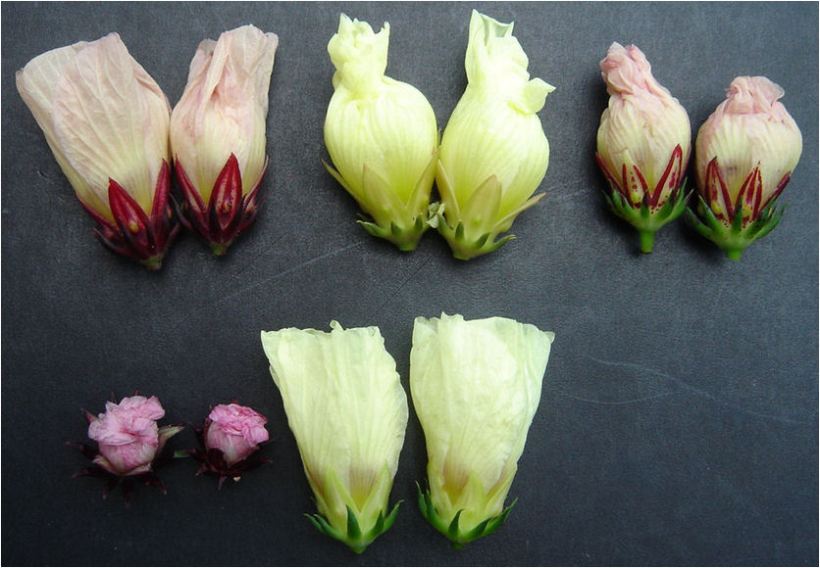
In Andhra cuisine, roselle is called gongura and is extensively used. The leaves are steamed with lentils and cooked with dal. Another unique dish is prepared by mixing fried leaves with spices and made into a gongura pacchadi, the most famous dish of Andhra cuisine that is often described as king of all Andhra foods.
In Burmese cuisine, called chin baung ywet (lit. sour leaf), the roselle is widely used and considered affordable. It is perhaps the most widely eaten and popular vegetable in Burma. The leaves are fried with garlic, dried or fresh prawns and green chili or cooked with fish. A light soup made from roselle leaves and dried prawn stock is also a popular dish.
Among the Paites tribe of the Manipur hibiscus sabdariffa and hibiscus cannabinus locally known as ‘anthuk’ are cooked along with chicken, fish, crab or pork or any meat, and cooked as a soup as one of their traditional cuisines. In the Khasi Hills of Meghalaya, the plant is locally known as Jajew, and the leaves are used in local cuisine, cooked with both dried and fresh fish.
In the Philippines, the leaves and flowers
are used to add sourness to chicken dish “Tinola” (chicken stew).
In Vietnam, the young leaves, stems and fruits are used for cooking soups with fish or eel.
In Mali, the dried and ground leaves, also called Djissima, are commonly used in Songhaï cuisine, in the regions of Timbuktu, Gao and their surroundings. It is the main ingredient in at least two dishes, one called Djissima-Gounday, where rice is slowly cooked in a broth containing the leaves and lamb, and the other dish is called Djissima-Mafé, where the leaves are cooked in a tomato sauce, also including lamb. Note that Djissima-Gounday is also considered an affordable dish.
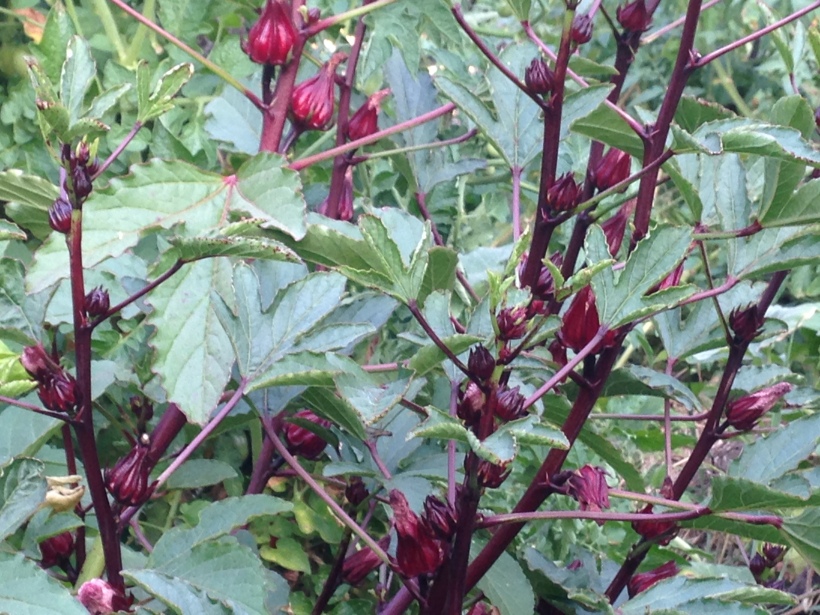
In the Caribbean, sorrel drink is made from sepals of the roselle. It is prepared by boiling dried sepals and calyces of the sorrel/flower of the plant in water for 8 to 10 minutes (or until the water turns red), then adding sugar. It is often served chilled. This is done in Trinidad and Tobago, Guyana, Antigua, Barbados, St. Lucia, Dominica, Grenada,and Jamaica where it is called ‘sorrel’.The drink is one of several inexpensive beverages (aguas frescas) commonly consumed in Mexico and Central America; they are typically made from fresh fruits, juices or extracts. It is very popular in Trinidad and Tobago especially as a seasonal drink during christmas where cinnamon, cloves and bay leaves are preferred to ginger. ]. It is also popular in Jamaica usually flavored with rum.
In Mali, Senegal, The Gambia, Burkina Faso and Benin calyces are used to prepare cold, sweet drinks popular in social events, often mixed with mint leaves, dissolved menthol candy, and/or fruit flavors.
The Middle Eastern and Sudanese “Karkade” (كركديه) is a cold drink made by soaking the dried Karkade calyces in cold water overnight in a refrigerator with sugar and some lemon or lime juice added. It is then consumed with or without ice cubes after the flowers have been strained. In Lebanon, toasted pine nuts are sometimes added.
Roselle is used in Nigeria to make a refreshing drink known as Zobo and natural fruit juices of pineapple and watermelon are added. Ginger is also sometimes added to the refreshing drink.
With the advent in the U.S. of interest in south-of-the-border cuisine, the calyces are sold in bags usually labeled “Flor de Jamaica” and have long been available in health food stores in the U.S. for making tea. In addition to being a popular homemade drink, Jarritos, a popular brand of Mexican soft drinks, makes a Flor de Jamaica flavored carbonated beverage. Imported Jarritos can be readily found in the U.S.
In the UK, the dried calyces and ready-made sorrel syrup are widely and cheaply available in Caribbean and Asian grocers. The fresh calyces are imported mainly during December and January to make Christmas and New Year infusions, which are often made into cocktails with rum. They are very perishable, rapidly developing fungal rot, and need to be used soon after purchase — unlike the dried product, which has a long shelf-life.
In Africa, especially the Sahel, roselle is commonly used to make a sugary herbal tea that is sold on the street. The dried flowers can be found in every market. Roselle tea is quite common in Italy where it spread during the first decades of the 20th century as a typical product of the Italian colonies. The Carib Brewery Trinidad Limited, a Trinidad and Tobago brewery, produces a ‘Shandy Sorrel’ in which the tea is combined with beer.
In Thailand, roselle is generally drunk as a cool drink, and it can be made into a wine.
Hibiscus flowers are commonly found in commercial herbal teas, especially teas advertised as berry-flavoured, as they give a bright red colouring to the drink.
Rosella flowers are sold as Wild Hibiscus flowers in syrup in Australia as a gourmet product. Recipes include filling them with goats cheese; serving them on baguette slices baked with brie; and placing one plus a little syrup in a champagne flute before adding the champagne — the bubbles cause the flower to open.
Jam and preserves
In Nigeria, rosella jam has been made since colonial times and is still sold regularly at community fetes and charity stalls. It is similar in flavour to plum jam, although more acidic. It differs from other jams in that the pectin is obtained from boiling the interior buds of the rosella flowers. It is thus possible to make rosella jam with nothing but rosella buds and sugar.
In Burma, the buds of the roselle are made into ‘preserved fruits’ or jams. Depending on the method and the preference, the seeds are removed or included. The jams, made from roselle buds and sugar, are red and tangy.
In India, Roselle is commonly made into a type of pickle.
“Sorrel jelly” is manufactured in Trinidad.
Rosella jam is made in Queensland, Australia as a home-made or speciality product sold at fetes and other community events.
Herbal medicine (high blood pressure)
Although a 2010 meta-analysis conducted by the Cochrane hypertension group concluded “No studies were identified that met the inclusion criteria” a more recent meta-survey (2015) in the Journal of Hypertension suggests a typical reduction in blood pressure of around 7.5/3.5 units (systolic/diastolic).
Phytochemicals
The Hibiscus leaves are a good source of polyphenolic compounds. The major identified compounds include neochlorogenic acid, chlorogenic acid, cryptochlorogenic acid, caffeoylshikimic acid and flavonoid compounds such as quercetin, kaempferol and their derivatives. The flowers are rich in anthocyanins, as well as protocatechuic acid. The dried calyces contain the flavonoids gossypetin, hibiscetine and sabdaretine. The major pigment, formerly reported as hibiscin, has been identified as daphniphylline. Small amounts of myrtillin (delphinidin 3-monoglucoside), chrysanthenin (cyanidin 3-monoglucoside), and delphinidin are present. Roselle seeds are a good source of lipid-soluble antioxidants, particularly gamma-tocopherol.